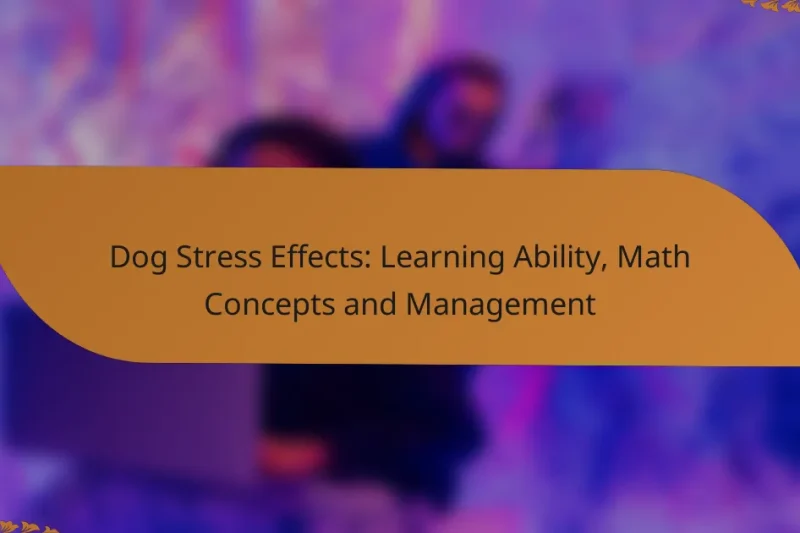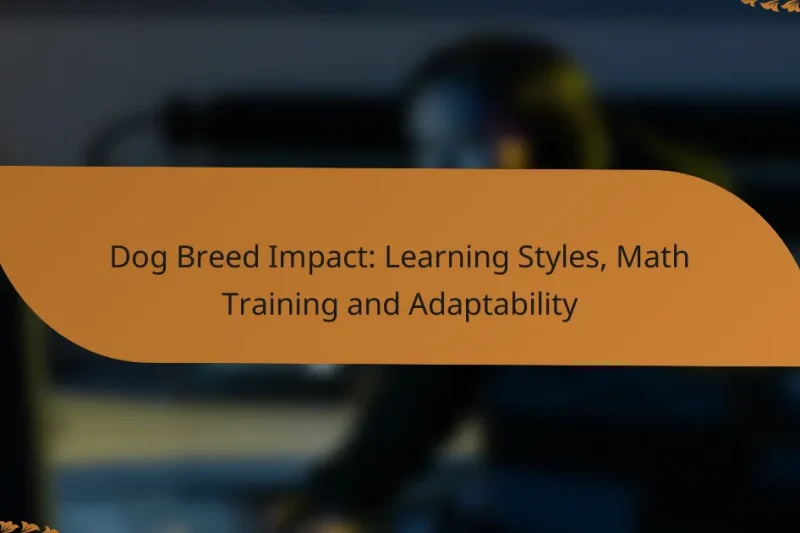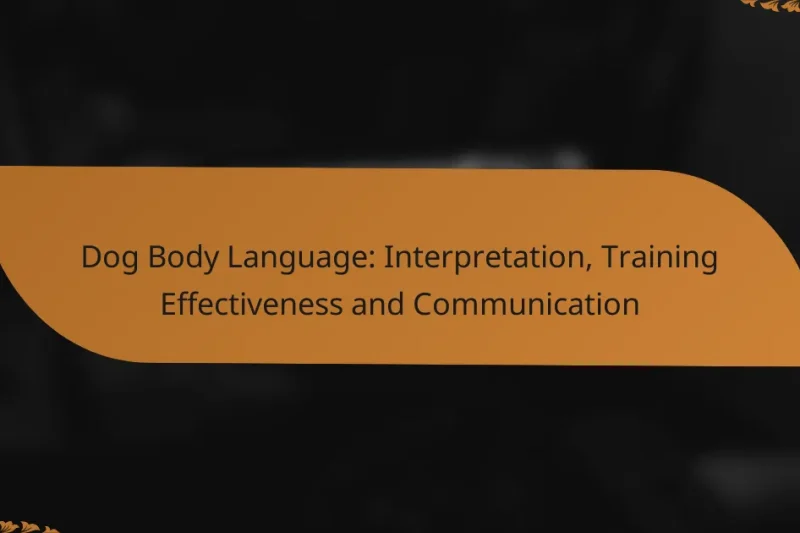Socialization plays a crucial role in children’s learning by enhancing their ability to interact and collaborate … Socialization: Role in Learning, Math Skills and DevelopmentRead more
Understanding Dog Behavior in Dog Math Training
Understanding dog behavior is essential for improving outcomes in math training. By recognizing how dogs react to different stimuli, trainers can adapt their techniques to foster better learning and retention of mathematical concepts. Employing effective methods, such as positive reinforcement and clear communication, can significantly enhance the training experience for both the dog and the owner.
Dog Attention Span: Evaluation, Training Sessions and Improvement
Understanding a dog’s attention span is essential for effective training and interaction. By evaluating their focus … Dog Attention Span: Evaluation, Training Sessions and ImprovementRead more
Dog Stress Effects: Learning Ability, Math Concepts and Management
Understanding the effects of stress on dogs is crucial for enhancing their learning abilities and overall … Dog Stress Effects: Learning Ability, Math Concepts and ManagementRead more
Dog Breed Impact: Learning Styles, Math Training and Adaptability
Understanding the impact of dog breeds on learning styles is crucial for effective training and adaptability. … Dog Breed Impact: Learning Styles, Math Training and AdaptabilityRead more
Dog Body Language: Interpretation, Training Effectiveness and Communication
Understanding dog body language is essential for interpreting their emotional states and intentions, which can significantly … Dog Body Language: Interpretation, Training Effectiveness and CommunicationRead more
Common Behavioral Challenges: Identification, Solutions and Training
Addressing common behavioral challenges in dogs, such as separation anxiety, excessive barking, and fear-based aggression, is … Common Behavioral Challenges: Identification, Solutions and TrainingRead more
How can dog behavior improve math training outcomes?
Understanding dog behavior is crucial for enhancing math training outcomes. By recognizing how dogs respond to various stimuli, trainers can tailor their methods to encourage better learning and retention of mathematical concepts.
Positive reinforcement techniques
Positive reinforcement involves rewarding desired behaviors to encourage their repetition. In math training, this can include treats, praise, or playtime when a dog successfully completes a task. Consistently applying these rewards helps dogs associate math training with positive experiences.
For effective reinforcement, ensure that rewards are immediate and appropriate to the dog’s preferences. Using high-value treats during initial training sessions can boost motivation, while gradually transitioning to lower-value rewards as the dog becomes more proficient can maintain engagement.
Understanding canine body language
Canine body language plays a significant role in interpreting a dog’s feelings during training. Signs of stress or confusion, such as tail tucking or excessive yawning, may indicate that the dog is struggling with the math concepts being taught. Recognizing these signals allows trainers to adjust their approach accordingly.
Conversely, signs of excitement and engagement, like a wagging tail or focused attention, suggest that the dog is enjoying the training. Observing these cues can help trainers determine when to introduce new challenges or when to reinforce existing skills.
Building trust through consistency
Consistency in training methods fosters trust between the dog and the trainer. By maintaining a predictable routine and using the same commands and rewards, dogs learn to feel secure and confident in their training environment. This trust is essential for effective learning, especially in complex tasks like math training.
To build this trust, establish a clear training schedule and stick to it. Avoid changing commands or rewards frequently, as this can confuse the dog and hinder progress. Regular practice sessions, even if brief, can reinforce learning and strengthen the bond between the dog and trainer.
What are effective training methods for dogs?
Effective training methods for dogs include techniques that promote understanding and communication between the owner and the pet. These methods often focus on positive reinforcement and clear cues to encourage desired behaviors.
Clicker training
Clicker training is a popular method that uses a small device to make a distinct sound, signaling to the dog that they have performed a desired action correctly. This technique helps dogs associate the sound with positive outcomes, such as treats or praise.
To implement clicker training, first, choose a clicker and a reward that your dog enjoys. Start by clicking the device immediately after your dog performs the desired behavior, then follow up with a treat. Consistency is key; ensure you click and reward every time at the beginning to reinforce the connection.
Target training
Target training involves teaching a dog to touch or follow a specific object, which can be useful for guiding them through various tasks. This method can help with more complex commands and behaviors by breaking them down into manageable steps.
Begin target training by introducing a target stick or your hand, encouraging your dog to touch it with their nose. Once they understand the concept, you can gradually increase the distance or complexity of the tasks. This method is effective for teaching tricks or guiding dogs to specific locations.
Positive reinforcement strategies
Positive reinforcement strategies focus on rewarding desirable behaviors to encourage their repetition. This approach is based on the principle that behaviors followed by positive outcomes are more likely to be repeated.
Common rewards include treats, verbal praise, or playtime. When using positive reinforcement, it’s essential to reward your dog immediately after they exhibit the desired behavior to create a strong association. Avoid punishment, as it can lead to fear and anxiety, which may hinder learning.
How does socialization affect dog training?
Socialization significantly impacts dog training by helping dogs become well-adjusted and responsive to commands. A well-socialized dog is typically more confident and less fearful, which enhances their ability to learn and engage during training sessions.
Exposure to various environments
Exposing dogs to different environments is crucial for their socialization and training. This exposure can include visits to parks, busy streets, or pet-friendly stores. Such experiences help dogs adapt to new stimuli, reducing anxiety and improving their focus during training.
When introducing your dog to new environments, start with quieter locations and gradually increase the level of activity. This approach allows your dog to build confidence without feeling overwhelmed.
Interaction with other dogs
Interaction with other dogs plays a vital role in socialization and can enhance training effectiveness. Dogs learn important social cues and behaviors from their peers, which can translate into better obedience and responsiveness. Regular playdates or visits to dog parks can facilitate these interactions.
However, it’s essential to monitor these interactions to ensure they remain positive. Aggressive or overly dominant dogs can negatively influence your dog’s behavior, so choose playmates wisely.
Impact on behavior during training
Socialization directly affects a dog’s behavior during training sessions. A well-socialized dog is more likely to remain calm and focused, making it easier to learn new commands and tricks. Conversely, a poorly socialized dog may exhibit fear or aggression, hindering their ability to train effectively.
To maximize training success, incorporate socialization into your routine. Regularly expose your dog to different people, sounds, and situations while reinforcing positive behaviors with treats or praise. This practice will create a more conducive learning environment for your dog.
What are common behavioral issues in dog math training?
Common behavioral issues in dog math training include distraction during sessions, fear or anxiety responses, and overexcitement or hyperactivity. Addressing these problems is essential for effective learning and a positive training experience.
Distraction during sessions
Distraction can significantly hinder a dog’s ability to focus during math training sessions. Common distractions include noises, other pets, or even the environment itself. To minimize distractions, conduct training in a quiet space and gradually introduce more stimulating environments as the dog becomes more proficient.
Establishing a consistent routine can help reduce distractions. For example, training at the same time each day can signal to your dog that it is time to focus. Use high-value treats to maintain their attention and encourage engagement.
Fear or anxiety responses
Fear or anxiety can manifest during math training, making it difficult for a dog to learn. Signs may include cowering, barking, or refusal to participate. It’s important to recognize these signs early and adjust your approach to create a more comfortable environment.
To alleviate fear, use positive reinforcement techniques and avoid harsh corrections. Gradually expose your dog to the training environment and use calming aids, such as anxiety wraps or pheromone diffusers, if necessary. Patience is key; allow your dog to progress at their own pace.
Overexcitement or hyperactivity
Overexcitement or hyperactivity can disrupt math training sessions, making it challenging for dogs to concentrate. Signs of hyperactivity include jumping, barking, or inability to sit still. To manage this behavior, ensure that your dog receives adequate physical exercise before training sessions.
Incorporate short breaks during training to help your dog release excess energy. Use commands that require focus, like “sit” or “stay,” to help channel their excitement into productive behavior. Consistent training sessions that are neither too long nor too short can also help maintain an appropriate energy level.
How can dog owners assess their dog’s readiness for math training?
Dog owners can assess their dog’s readiness for math training by observing their behavior, considering their age and breed, and conducting health assessments. These factors help determine if a dog is mentally and physically prepared for the challenges of learning mathematical concepts.
Behavioral signs of readiness
Behavioral signs of readiness include a dog’s ability to focus, engage in play, and respond to commands. A dog that shows curiosity and enthusiasm during training sessions is likely more prepared for math training. Look for signs such as tail wagging, attentive posture, and eagerness to participate.
Additionally, if your dog demonstrates problem-solving skills during playtime or shows interest in interactive toys, these can be indicators of their readiness to tackle math-related tasks.
Age and breed considerations
Age plays a crucial role in a dog’s readiness for math training. Generally, dogs between 6 months and 3 years old are more receptive to learning new concepts. Puppies may struggle with attention spans, while older dogs might have established habits that could hinder learning.
Breed also influences readiness; some breeds, like Border Collies and Poodles, are known for their intelligence and eagerness to learn, making them more suitable candidates for math training. In contrast, breeds that are less trainable may require more patience and tailored approaches.
Health assessments
Before starting math training, it’s essential to ensure your dog is in good health. A visit to the veterinarian can help identify any underlying health issues that might affect their ability to learn. Conditions such as arthritis or vision problems can hinder a dog’s performance during training.
Regular health check-ups can help maintain your dog’s overall well-being, ensuring they are physically capable of engaging in training activities. Keep an eye on their energy levels and behavior; a healthy dog is more likely to be ready for the mental challenges of math training.
What are the prerequisites for successful dog math training?
Successful dog math training requires a foundation of basic obedience, strong bonding between the owner and dog, and an understanding of the dog’s unique learning style. These elements help create an effective learning environment that enhances the dog’s ability to grasp mathematical concepts.
Basic obedience commands
Basic obedience commands such as sit, stay, and come are essential for effective dog math training. These commands establish a framework for communication and control, allowing the owner to direct the dog’s attention and focus during training sessions. Consistent practice of these commands helps reinforce discipline and responsiveness.
To ensure your dog masters these commands, use positive reinforcement techniques like treats or praise. Short training sessions of about 5-10 minutes can be effective, as dogs typically have limited attention spans. Regular practice will solidify these commands, making it easier to introduce more complex tasks.
Owner-dog bonding activities
Engaging in bonding activities strengthens the relationship between the owner and the dog, which is crucial for successful training. Activities like playing fetch, going for walks, or participating in agility courses can enhance trust and cooperation. A strong bond encourages the dog to be more attentive and eager to learn.
Consider incorporating fun games that involve problem-solving, such as hiding treats or using puzzle toys. These activities not only build a connection but also stimulate the dog’s mind, preparing them for the cognitive challenges of math training.
Understanding canine learning styles
Each dog has a unique learning style, which can significantly impact their ability to grasp math concepts. Some dogs may learn best through visual cues, while others may respond better to auditory signals or hands-on experiences. Observing your dog’s reactions during training can help identify their preferred learning method.
To accommodate different learning styles, vary your training techniques. For example, use visual aids like colored mats for spatial awareness or verbal cues for commands. Tailoring your approach to your dog’s learning style can enhance their understanding and retention of mathematical principles.





